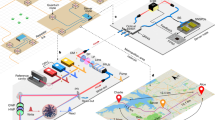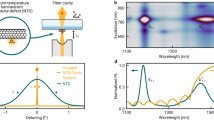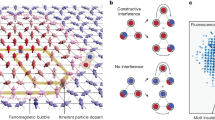Abstract
Boson bunching is among the most remarkable features of quantum physics. A celebrated example in optics is the Hong–Ou–Mandel effect, where the bunching of two photons arises from a destructive quantum interference between the trajectories where they both either cross a beamsplitter or are reflected. This effect takes its roots in the indistinguishability of identical photons. Hence, it is generally admitted—and experimentally verified—that bunching vanishes as soon as photons can be distinguished, for example, when they occupy distinct time bins or have different polarizations. Here we disprove this alleged straightforward link between indistinguishability and bunching by exploiting a recent finding in the theory of matrix permanents. We exhibit a family of optical circuits such that the bunching of photons into two modes can be substantially boosted by making them partially distinguishable via an appropriate polarization pattern. This boosting effect is already visible in a seven-photon interferometric process, making the observation of this phenomenon within reach of current photonic technology. This unexpected behaviour questions our understanding of multiparticle interference in the grey zone between indistinguishable bosons and classical particles.
This is a preview of subscription content, access via your institution
Access options
Access Nature and 54 other Nature Portfolio journals
Get Nature+, our best-value online-access subscription
$29.99 / 30 days
cancel any time
Subscribe to this journal
Receive 12 print issues and online access
$209.00 per year
only $17.42 per issue
Buy this article
- Purchase on Springer Link
- Instant access to full article PDF
Prices may be subject to local taxes which are calculated during checkout






Similar content being viewed by others
Data availability
The data supporting the study and figures are available upon request. We acknowledge A. Franzen’s ComponentLibrary for use in making the figures.
Code availability
The project relies on the packages PERMANENTS.JL (https://github.com/benoitseron/Permanents.jl) and BOSONSAMPLING.JL (https://github.com/benoitseron/BosonSampling.jl)48. The source code used for generating the figures and the data of this paper is available on GitHub and the data from OSF (https://osf.io/ex63z/).
References
Wootters, W. K. & Zurek, W. H. Complementarity in the double-slit experiment: quantum nonseparability and a quantitative statement of Bohr’s principle. Phys. Rev. D 19, 473–484 (1979).
Greenberger, D. M. & Yasin, A. Simultaneous wave and particle knowledge in a neutron interferometer. Phys. Lett. A 128, 391–394 (1988).
Mandel, L. Coherence and indistinguishability. Opt. Lett. 16, 1882–1883 (1991).
Feynman, R. P., Leighton, R. B. & Sands, M. The Feynman Lectures on Physics (Addison-Wesley, 1963).
Hong, C.-K., Ou, Z.-Y. & Mandel, L. Measurement of subpicosecond time intervals between two photons by interference. Phys. Rev. Lett. 59, 2044–2046 (1987).
Gerry, C., Knight, P. & Knight, P. L. Introductory Quantum Optics (Cambridge Univ. Press, 2005).
Spagnolo, N. et al. General rules for bosonic bunching in multimode interferometers. Phys. Rev. Lett. 111, 130503 (2013).
Shchesnovich, V. Universality of generalized bunching and efficient assessment of boson sampling. Phys. Rev. Lett. 116, 123601 (2016).
Carolan, J. et al. On the experimental verification of quantum complexity in linear optics. Nat. Photon. 8, 621–626 (2014).
Bapat, R. B. & Sunder, V. S. On majorization and Schur products. Linear Algebra Appl. 72, 107–117 (1985).
Drury, S. A counterexample to a question of Bapat and Sunder. Electron. J. Linear Algebra 31, 69–70 (2016).
Shchesnovich, V. S. The permanent-on-top conjecture is false. Linear Algebra Appl. 490, 196–201 (2016).
Tichy, M. C. Sampling of partially distinguishable bosons and the relation to the multidimensional permanent. Phys. Rev. A 91, 022316 (2015).
Shchesnovich, V. Partial indistinguishability theory for multiphoton experiments in multiport devices. Phys. Rev. A 91, 013844 (2015).
Dittel, C. et al. Totally destructive interference for permutation-symmetric many-particle states. Phys. Rev. A 97, 062116 (2018).
Zhang, F. Matrix Theory: Basic Results and Techniques (Springer, 2011).
Shchesnovich, V. Tight bound on the trace distance between a realistic device with partially indistinguishable bosons and the ideal bosonsampling. Phys. Rev. A 91, 063842 (2015).
Schur, I. Über endliche Gruppen und hermitesche Formen. Math. Zeitschrift 1, 184–207 (1918).
Oppenheim, A. Inequalities connected with definite hermitian forms. J. Lond. Math. Soc. 1, 114–119 (1930).
Gloub, G. H. & Van Loan, C. F. Matrix Computations 3rd edn (Johns Hopkins Univ. Press, 1996).
Flamini, F., Spagnolo, N. & Sciarrino, F. Photonic quantum information processing: a review. Rep. Prog. Phys. 82, 016001 (2018).
Pelucchi, E. et al. The potential and global outlook of integrated photonics for quantum technologies. Nat. Rev. Phys 4, 194–208 (2021).
Wang, H. et al. Toward scalable boson sampling with photon loss. Phys. Rev. Lett. 120, 230502 (2018).
Wang, H. et al. Boson sampling with 20 input photons and a 60-mode interferometer in a 1014-dimensional Hilbert space. Phys. Rev. Lett. 123, 250503 (2019).
Wang, J., Sciarrino, F., Laing, A. & Thompson, M. G. Integrated photonic quantum technologies. Nat. Photon. 14, 273–284 (2020).
Hoch, F. et al. Reconfigurable continuously-coupled 3D photonic circuit for Boson Sampling experiments. npj Quantum Inf. 8, 55 (2022).
Carolan, J. et al. Universal linear optics. Science 349, 711–716 (2015).
Crespi, A. et al. Suppression law of quantum states in a 3D photonic fast Fourier transform chip. Nat. Commun. 7, 10469 (2016).
Jönsson, M. & Björk, G. Evaluating the performance of photon-number-resolving detectors. Phys. Rev. A 99, 043822 (2019).
Provazník, J., Lachman, L., Filip, R. & Marek, P. Benchmarking photon number resolving detectors. Opt. Express 28, 14839–14849 (2020).
Cheng, R. et al. A 100-pixel photon-number-resolving detector unveiling photon statistics. Nat. Photon. 17, 112–119 (2023).
Pryde, G. J. & White, A. G. Creation of maximally entangled photon-number states using optical fiber multiports. Phys. Rev. A 68, 052315 (2003).
Tichy, M. C. et al. Four-photon indistinguishability transition. Phys. Rev. A 83, 062111 (2011).
Ra, Y.-S. et al. Nonmonotonic quantum-to-classical transition in multiparticle interference. Proc. Natl Acad. Sci. USA 110, 1227–1231 (2013).
Tichy, M. C. Interference of identical particles from entanglement to boson-sampling. J. Phys. B 47, 103001 (2014).
Tillmann, M. et al. Generalized multiphoton quantum interference. Phys. Rev. X 5, 041015 (2015).
Turner, P. S. Postselective quantum interference of distinguishable particles. Preprint at https://arxiv.org/abs/1608.05720 (2016).
Jones, A. E. et al. Multiparticle interference of pairwise distinguishable photons. Phys. Rev. Lett. 125, 123603 (2020).
Menssen, A. J. et al. Distinguishability and many-particle interference. Phys. Rev. Lett. 118, 153603 (2017).
Shchesnovich, V. & Bezerra, M. Collective phases of identical particles interfering on linear multiports. Phys. Rev. A 98, 033805 (2018).
Jones, A. E. Distinguishability in Quantum Interference. PhD thesis, Imperial College London (2019).
Zhang, F. An update on a few permanent conjectures. Special Matrices 4, 305–316 (2016).
Drury, S. et al. A real counterexample to two inequalities involving permanents. Math. Inequalities Appl. 20, 349–352 (2017).
Clements, W. R., Humphreys, P. C., Metcalf, B. J., Kolthammer, W. S. & Walmsley, I. A. Optimal design for universal multiport interferometers. Optica 3, 1460–1465 (2016).
Tichy, M. C., Tiersch, M., de Melo, F., Mintert, F. & Buchleitner, A. Zero-transmission law for multiport beam splitters. Phys. Rev. Lett. 104, 220405 (2010).
Zhang, F. Notes on Hadamard products of matrices. Linear Multilinear Algebra 25, 237–242 (1989).
Aaronson, S. & Arkhipov, A. The computational complexity of linear optics. In Proc. Forty-Third Annual ACM Symposium on Theory of Computing 333–342 (ACM, 2011).
Seron, B. & Restivo, A. BosonSampling.jl: a Julia package for quantum multi-photon interferometry. Preprint at https://arxiv.org/abs/2212.09537 (2022).
Acknowledgements
We thank S. Drury for useful correspondence, as well as F. Flamini and V. Shchesnovich for valuable discussions. B.S. is a Research Fellow and L.N. was a Postdoctoral Researcher of the Fonds de la Recherche Scientifique – FNRS (Belgium). N.J.C. acknowledges support from the Fonds de la Recherche Scientifique – FNRS (Belgium) under grant no. T.0224.18 and by the European Union under project ShoQC within ERA-NET Cofund in Quantum Technologies (QuantERA) programme. L.N. also acknowledges funding from FCT-Fundação para a Ciência e a Tecnologia (Portugal) via project no. CEECINST/00062/2018. This project has also received funding from the European Union’s Horizon 2020 research and innovation programme under Marie Skłodowska-Curie grant agreement no. 956071.
Author information
Authors and Affiliations
Contributions
All authors developed the original concepts, derived the formulae, discussed the results and wrote the paper. B.S. implemented the numerical simulations.
Corresponding author
Ethics declarations
Competing interests
The authors declare no competing interests.
Peer review
Peer review information
Nature Photonics thanks Lorenzo Marrucci and the other, anonymous, reviewer(s) for their contribution to the peer review of this work.
Additional information
Publisher’s note Springer Nature remains neutral with regard to jurisdictional claims in published maps and institutional affiliations.
Supplementary information
Supplementary Information
Supplementary information including one figure.
Rights and permissions
Springer Nature or its licensor (e.g. a society or other partner) holds exclusive rights to this article under a publishing agreement with the author(s) or other rightsholder(s); author self-archiving of the accepted manuscript version of this article is solely governed by the terms of such publishing agreement and applicable law.
About this article
Cite this article
Seron, B., Novo, L. & Cerf, N.J. Boson bunching is not maximized by indistinguishable particles. Nat. Photon. 17, 702–709 (2023). https://doi.org/10.1038/s41566-023-01213-0
Received:
Accepted:
Published:
Issue Date:
DOI: https://doi.org/10.1038/s41566-023-01213-0
This article is cited by
-
An atomic boson sampler
Nature (2024)
-
Dissimilar photons can bunch too
Nature Photonics (2023)



